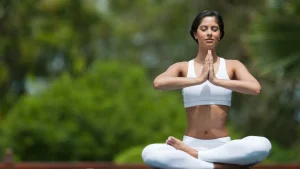Yoga and meditation are powerful practices on their own, but combining them can unlock even greater benefits for your body, mind, and soul. Yoga helps to release physical tension and mental stress, while meditation sharpens your focus and brings mental clarity. Together, they create a harmony that can elevate your well-being and bring balance to your daily life.
The Differences Between Yoga and Meditation
Yoga and meditation might seem similar, but they have distinct focuses.
- Yoga is a physical practice involving postures (asanas) and breath control to improve flexibility, strength, and overall physical health. It helps align the body and breath while promoting mental clarity and emotional well-being.
- Meditation, on the other hand, is a mental practice. It focuses on observing thoughts, emotions, and sensations without judgment, helping you cultivate inner awareness and peace.
Though different, these practices complement each other beautifully by aiming for the same ultimate goal: the union of body, mind, and spirit.
How Yoga and Meditation Complement Each Other
Yoga and meditation work hand in hand to create a balanced mind-body connection. Here’s how:
- Yoga prepares the body for meditation by releasing tension, increasing flexibility, and calming the mind.
- Meditation deepens your yoga practice by promoting focus, inner stillness, and mental clarity.
Together, they enhance relaxation, mindfulness, and self-awareness, allowing you to feel more present and connected in your daily life. For more inspiration on how yoga and meditation can enrich your life, check out our blog on How to Meditate Daily and Establish a Meditation Routine
Should You Do Yoga Before or After Meditation?
There’s no fixed rule about whether yoga should come before or after meditation. It’s a personal choice, based on what feels best for you:
- Yoga before meditation: Yoga can relax your body and mind, making it easier to sit still and focus during meditation.
- Meditation before yoga: Meditation can help center your mind, set intentions, and create emotional balance before moving into a physical practice.
Experiment with both approaches to discover what suits your needs and enhances your overall experience.
Benefits of Combining Yoga and Meditation
1. Enhances Mindfulness and Strengthens the Mind-Body Connection
Practicing yoga postures and mindful breathing enhances your awareness of your thoughts, emotions, and physical sensations. Meditation amplifies this mindfulness, helping you stay grounded and present. Together, they cultivate self-awareness and reduce stress, promoting overall mental health.
2. Cultivates Inner Peace and Reduces Stress
Yoga eases physical tension, while meditation quiets the mind. By combining the two, you can release daily stress, find calm, and connect with your inner peace. For tips on creating a serene environment, explore our guide to mindfulness practices.
3. Improves Focus and Concentration
Both yoga and meditation train your mind to stay focused and attentive. Whether you’re holding a pose or observing your breath, these practices build concentration, improving productivity and efficiency in everyday activities.
4. Increases Emotional Regulation
Yoga helps you connect with your breath and body, enhancing emotional awareness. Meditation teaches you to observe your emotions without reacting immediately, providing a pause to reflect and choose your response wisely.
5. Boosts Spiritual Awareness and Self-Discovery
Yoga and meditation open the door to deeper self-reflection and spiritual awareness. They help you connect with your inner self, uncover your values, and discover your life’s purpose.
6. Reduces Chronic Pain
Yoga’s gentle stretches and mindful movements improve flexibility and reduce tension, while meditation shifts your focus away from pain, helping you manage discomfort with greater ease.
7. Improves Sleep Quality
A combination of yoga and meditation can create a soothing bedtime routine that calms your mind and relaxes your body, paving the way for restful sleep.
Practicing Meditation in Motion During Yoga
Meditating while practicing yoga deepens your experience. Here’s how:
Meditating While Holding Yoga Poses
- Body Awareness: Focus on sensations in your body as you hold each pose.
- Breath Awareness: Pay attention to your breath, ensuring it flows smoothly.
- Mindfulness: Observe thoughts and emotions without judgment, staying present in the pose.
Meditating While Transitioning Between Poses
- Mindful Movement: Be aware of each movement, from muscle engagement to alignment.
- Continuous Breath Focus: Sync your movements with your breath for a meditative flow.
- Mantras: Use affirmations like “I am present” to anchor your mind during transitions.
For more ideas on combining mindfulness with movement, read our blog on yoga for beginners.
Tips for Combining Yoga With Meditation
- Set Realistic Goals: Start with small, achievable intentions, like reducing stress or improving flexibility.
- Explore Different Practices: Experiment with various styles of yoga and meditation to find what resonates with you.
- Create a Sacred Space: Dedicate a quiet, clutter-free area for your practice.
- Listen to Your Body: Honor your limits and modify poses or techniques as needed.
- Allow Time for Both: Commit time to fully immerse in both practices without distractions.
Final Thoughts
Combining yoga and meditation creates a powerful synergy that enhances physical and mental well-being. Whether you’re looking to reduce stress, improve focus, or deepen your spiritual awareness, this harmonious practice offers endless benefits.
Ready to take the next step? Explore our blog on How to Choose the Right Yoga Teacher Training in India and start your journey towards a healthier, more balanced life today!






